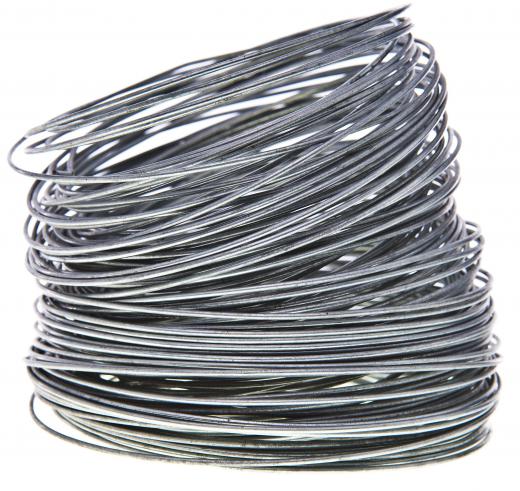Galvanized steel is steel that has gone through a chemical process to keep it from corroding. The steel gets coated in layers of zinc oxide because this protective metal does not get rusty as easily. The coating also gives the steel a more durable, hard to scratch finish that many people find attractive. For countless outdoor, marine, or industrial applications, galvanized steel is an essential fabrication component.
How It's Made

One of the most common ways of making steel resist rust is by combining (alloying) it with a metal that is less likely to corrode: zinc. When steel is submerged in melted zinc, a chemical reaction permanently bonds the zinc to the steel. Therefore, the zinc isn't exactly a sealer, like paint, because it doesn't just coat the other metal; it actually permanently becomes a part of it. The most external layer is all zinc, but successive layers are a mixture of zinc and iron, with an interior of pure steel.

This process, known as hot-dipped galvanization, is one of the most common methods of making galvanized steel, but it's not the only one. Continuous sheet galvanizing runs a steel sheet or wire through molten zinc; it's also a form of hot-dipping, but leaves a thinner layer of the protective metal. Steel can also be painted or sprayed with zinc, although neither method creates the strong bond that hot-dipping does. Electrogalvanizing or electroplating uses electricity to create the bond between the two metals, which results in relatively thin layer of zinc.

The degree of galvanizing is usually described as the zinc's weight per surface area rather than its thickness, because this gives a better representation of how much metal has been applied. Steel often gets galvanized after individual parts have been formed, such as braces, nails, screws, beams, or studs. Continuous sheet galvanizing is often done before the metal is used to create products, however, and can withstand some bending and forming without flaking.
Benefits of Galvanization

Zinc protects steel in two ways. First, it is highly resistant to rust; iron, a major component of steel, reacts very easily with oxygen and moisture and will eventually disintegrate. The layer of zinc on the surface prevents those elements from reaching the steel so quickly. It also develops a patina — a layer of zinc oxides, salts, and other compounds — that offers further protection. Zinc is also extremely durable and scratch resistant, and has a satiny appearance that many find attractive.

The outer layer also protects the steel by acting as a "sacrificial layer." If, for some reason, rust does take hold on the surface of galvanized steel, the zinc will get corroded first. Even in areas where the surface is scratched or damaged, the surrounding zinc will still corrode before the steel does. The lifespan of galvanized steel varies, but industrial steel with a 3.9 mil (0.0039 inches or 0.09906 mm) thick coating can last more than 70 years without maintenance under average conditions.
Uses
Galvanized steel can be found almost everywhere. Many individuals live in steel frame houses, and buildings are often made with galvanized steel roofs. There are multiple steel parts in cars that help protect them from the weather, and it's used in many marine applications due to its ability to withstand the salt and the elements. Besides being inexpensive, durable and effective, this metal is also popular because it can be recycled and reused multiple times.
Disadvantages
There are relatively few disadvantages to galvanization, but it's not a good method for protecting all steel items. Some objects cannot be hot-dipped, often because they are too large or too small, and other forms of galvanizing often are not as protective and long-lasting. Eventually, the zinc will be corroded, although how long this takes depends on the thickness of the coating and the environment. Galvanized steel has a much shorter lifespan when it's regularly exposed to rain or seawater.
Galvanized steel that is cooled too slowly or stacked together before they have cooled completely can also have the outer zinc layer peel away. In some cases, small gaps can form between the zinc and the underlying alloy, which can also cause peeling. When a very thick coat of zinc is applied, it can also become brittle and flake off.
Alternatives to Galvanization
Some metal items cannot be galvanized effectively; the coating of zinc would be too thick on a small screw, for example. In many cases, stainless steel, made with chromium, is used instead. Unlike galvanized metals, stainless steel is not coated in the metal; chromium is part of the composition of the steel alloy.
